A refreshing jelly dessert for the summer: Orange Jelly or Mikan Jelly (みかんゼリー). This crowd-pleasing treat makes a perfect dessert to serve at your backyard parties.
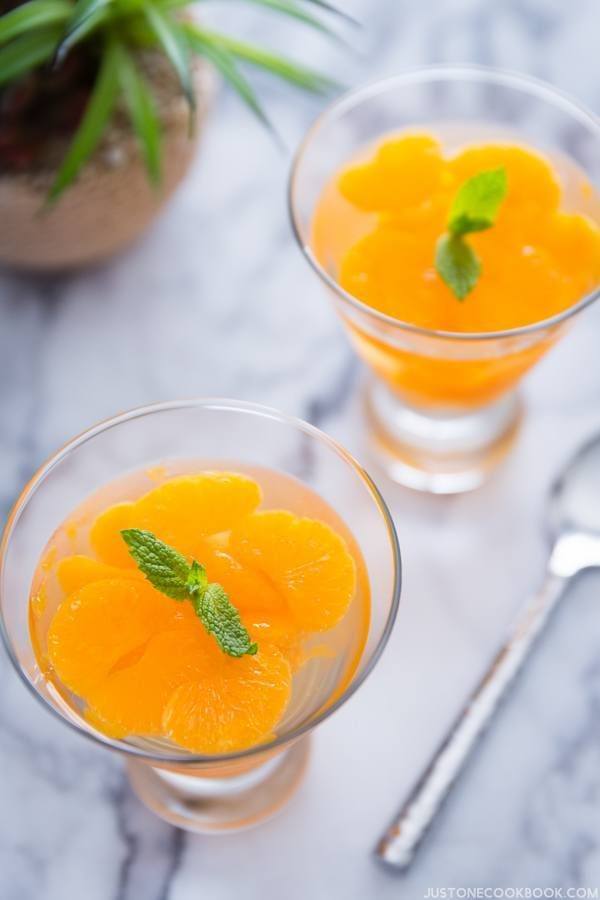
This past summer when we were in Japan, my children went crazy for various Japanese jelly. In Japan’s hot and humid summer, we were always craving for some cold treats. Besides ice cream and shaved ice, we often picked up some fruit jelly (フルーツゼリー) when we shop at supermarkets or convenience stores.
My daughter’s all-time favorite was this Mikan Jelly (みかんゼリー). Mikan is the Japanese word for a type of orange similar to clementine, tangerine, or mandarin orange.
In winter months when fresh Mikan are in season, she would easily inhale 10 of them in one sitting if she’s not being watched. This simple orange jelly was something she totally enjoyed eating this summer.

Ever since we came back to the U.S., she kept saying how much she misses her jelly and this went on like 2 months, non stop! Our house was under renovation and we didn’t have a kitchen, so I kept procrastinating by saying later, later, later…
Homemade Orange Jelly
The other day, when she was in school, I decided to pick up a can of mandarin oranges and made this jelly to surprise her. It’s really easy to make, and as a mom, I like that I can control the amount of sugar that goes into the jelly.
When we came back from school and it was snack time, I brought these orange jelly in front of her, and she had this huge smile on her face and squealed. This is why I cook; her smile made my day 1000 times better.

Use Gelatin Sheet instead of Gelatin Powder for Orange Jelly
I’ve shared Japanese jelly desserts like Mizu Yokan and Fruit Jelly this year, but instead of gelatin, I’ve been using vegetarian/vegan-friendly Kanten to make jellies.
I kind of forgot how awful gelatin powder smelled when I decided to make this jelly with gelatin powder. I’m not a vegetarian/vegan, but the smell was so awful that it completely turned me off to use gelatin powder. For the first batch that I tested, I actually throw them away because I couldn’t stand the smell. I checked for other’s feedback for gelatin powder on the internet and learned that gelatin sheet (or gelatin leaf) has much less smell. To improve this recipe, I purchased this German brand of gelatin sheet from Amazon.
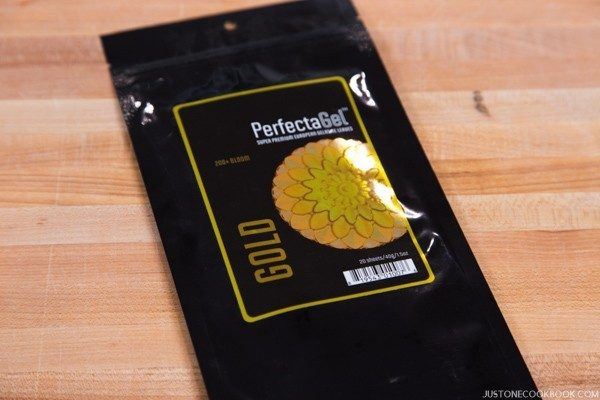
The gelatin sheets are very thin and almost translucent. Each sheet is 2.5 gram and there are 20 sheets in the package.
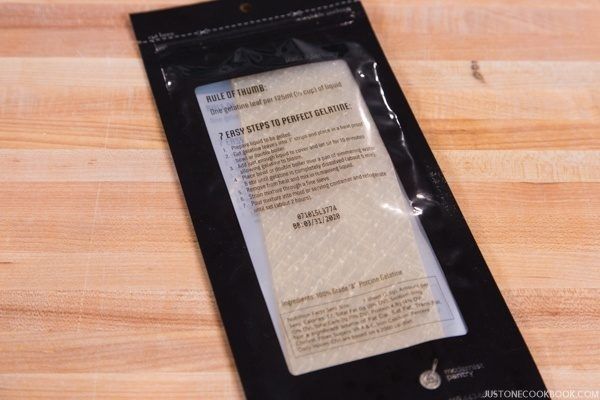
I smelled the sheet hesitantly because of the pungent issue with gelatin powder. What a surprise! The gelatin sheets do not smell at all. These gelatin sheets were super pleasant to work with, and if you are reluctant to make jelly because of the gelatin powder smell, definitely try the gelatin sheets!
Plus, gelatin sheets result in a clearer, more transparent final product than gelatin powder. So what’s not to love when you basically have a clearer gelatin with a neutral flavor!


Orange Jelly
Ingredients
- 2 gelatin sheets (2 sheets are equivalalent to 2 tsp (4 g) gelatin powder)
- 3 Tbsp hot water
- 1 can mandarin oranges (15 oz, 425 g; certain tropical fruits such as pineapples and kiwis have an enzyme that can prevent gelatin from setting; therefore, they need to be heated through completely, which will destroy the enzyme.)
- ¾ cup syrup from the mandarin oranges can (¾ cup + 4 tsp to be precise)
- 3 Tbsp sugar
Instructions
- Gather all the ingredients.
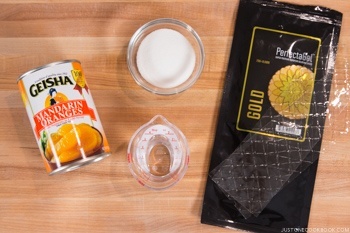
- If you are using gelatin sheets, cut them into thin ½ inch (1.3 cm) strips. Put gelatin (powder/sheets) in a bowl and pour 3 Tbsp hot water. If you are using gelatin sheets, we’ll need to melt the gelatin with a double boiler (Step 3). Please make sure to use a heat resistant bowl that is larger than the opening of the saucepan.
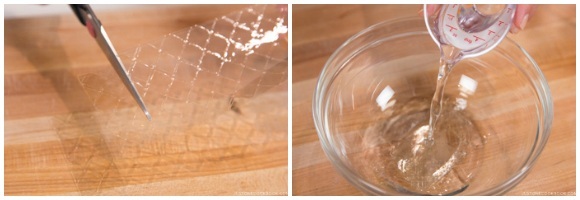
- Drain the mandarin oranges into a sieve over a bowl or measuring cup. There should be 200 ml (¾ cup + 4 tsp) of syrup. Save the syrup and transfer the oranges to a plate.
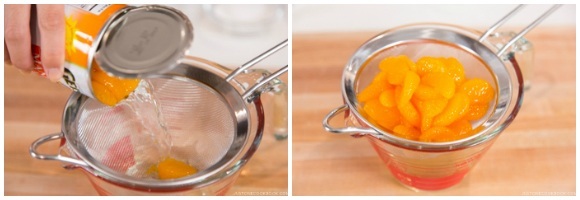
- In a small saucepan, bring roughly ½ cup of water to simmer and place the bowl of gelatin mixture over the saucepan. The steam will immediately warm up the glass bowl and start dissolving the gelatin.
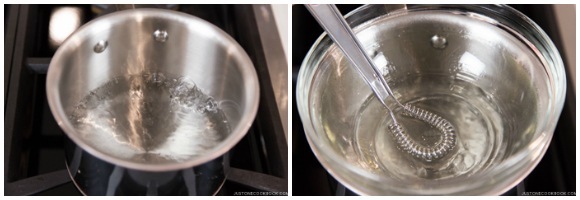
- When the gelatin has completely melted, add 3 Tbsp (40 g) sugar and whisk until all the sugar has been dissolved.
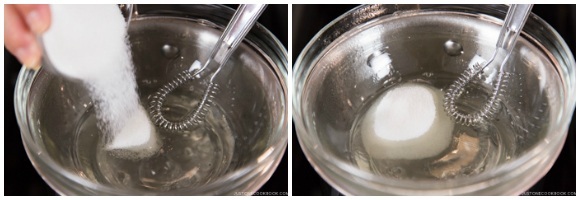
- Mix the gelatin mixture with the 200 ml (¾ cup + 4 tsp) syrup.
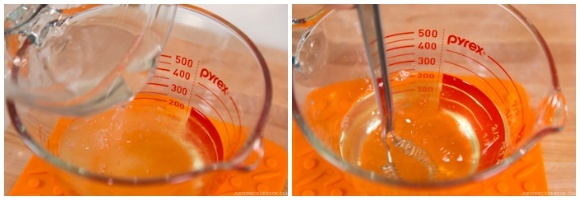
- Place the mandarin oranges in the serving glasses. Then pour the gelatin mixture over it. When it has cooled to room temperature, store in the refrigerator until it sets, about several hours. Garnish with mint and enjoy!
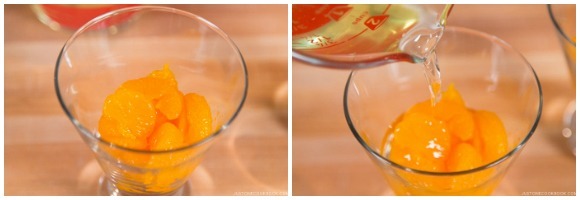
Notes
- 1 sheet gelatin = 1 tsp (2 g) gelatin powder
- 3 ½ sheets = approx 1 envelope Knox gelatin powder (7 g)
- 4 sheets = approx 1 Tbsp gelatin powder
- 1 tsp gelatin powder = ½ tsp kanten powder
- 1 tsp gelatin powder = 1 tsp agar powder
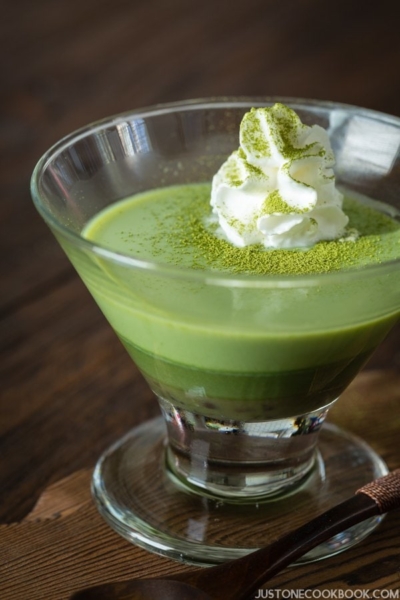
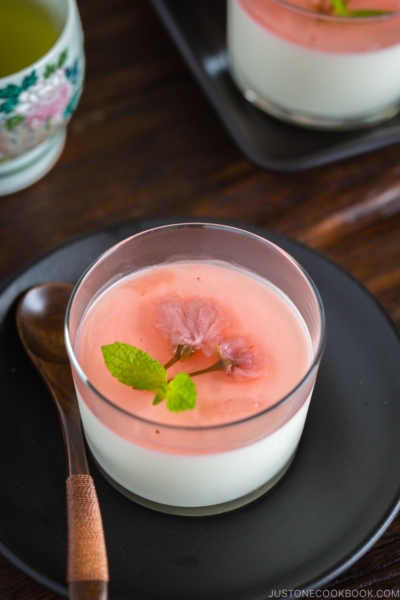
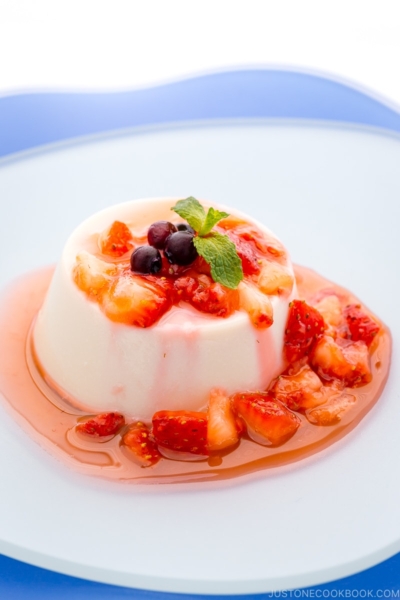
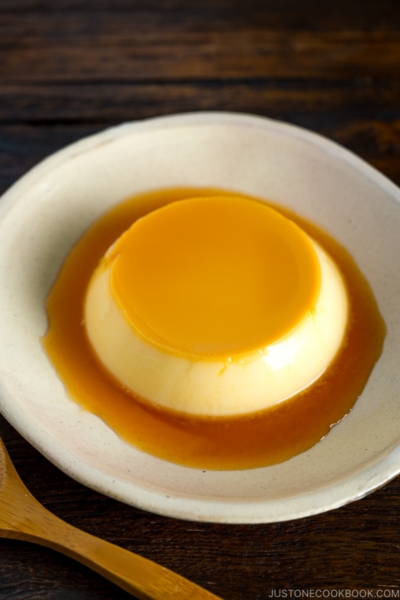





It was fast and easy, without the terrible smell of traditional powdered gelatin. Great recipe as always. Was wondering if you had any more jelly recipes that you haven’t shown us? LOL Thanks again.
Hi Mandy!
We are so happy to hear you enjoyed this jelly!
We have more jelly recipes with Agar Agar. Please check it out!
https://www.justonecookbook.com/#search/q=agar%20agar
Thank you for trying this recipe.😊
Made it and it tasted good. Can you make this with honey instead of sugar? If so, how much honey? Or can you use less sugar?
Hi Esther!
Thank you very much for trying this recipe and for your kind feedback.
Yes. You may reduce the amount of sugar or use honey instead.
If you are using honey, we recommend half of the original sugar amount.
We hope this helps!
How would you substitute agar agar in this recipes? Also, how long does agar agar last after opening?
Thanks, I hope your family is safe.
Hi Jennifer! First of all, agar agar will have a different texture as this jelly (it will be much firmer).
Agar info is in Notes section of my recipe: 1 tsp. gelatin powder = 1 tsp. agar/kanten powder
I hope you and your family stay safe and healthy during this challenging time. Thank you for your well wishes.
Is there any way to use fresh oranges/clementines instead? Would it be good?
Hi Catherine! You can use fresh fruits. Please adjust the sugar amount as I have used syrup from the can as a part of sweetness for this recipe. 🙂
It was delicious!!!
So happy to hear! Thanks so much for trying my recipe!
What can I use rather than gelatin sheets? Powdered? Measurement? Sounds delicious!
HI Lori! As I mentioned in the blog post, you can use gelatin powder if you don’t mind the awful odor (or maybe you know a brand that doesn’t have the odor?). You can also use agar agar (kanten) instead of gelatin. Measurement is in Note section.
Can’t wait to try this yummy dessert. Your explanations and video are EXCELLENT for all your recipes. Your neighbor
Hi Chiyo! Thank you so much for your kind words. Hope you enjoy this recipe! 🙂
Thank you for this great jelly recipe Nami! And I wish you a beautiful time now before Thanksgiving, a holiday we don’t have here in Sweden.
Last summer, only thanks to you and your blog, I were introduced to such a thing as kanten that I hadn’t known before. And I have used it and enjoyed it a lot since it is vegan.
Oh yes, I can remember gelatin smells pretty awful and the idea to mix fruit with bone broth isn’t very pleasant.
Would kiwi and ananas fruits make even kanten not set?
And I wonder if it’s possible to substitute for the canned clementines? Canned food and especially fruit is rather a big nono here unless it’s packed in paper cartoons, and we are trying to eat fresh fruit as fas as it is possible. Can I use fresh clementines or satsumas on this recipe?
Best wishes and thanks, hope you enjoy a beautiful fall this november days!
Hi Genus! Thanks so much! I guess you are getting ready for Christmas! 🙂 I’m happy to hear you learned about Kanten from me and have used it. It’s a wonderful ingredient for vegetarian and vegan desserts! For Kanten, you don’t have to worry about the kiwi and pineapple issue. 🙂 And yes, you can use fresh fruits. Please adjust the sugar amount as I have used syrup from the can as a part of sweetness for this recipe (sorry it’s too much hassle…). Thank you for your sweet wishes, Genus! xo
Thank you for your comment about being able to use other fruit (pineapple, kiwi) with kanten without the problems with gelatin. Good to know for those that don’t use meat products. Thanks so much for all the recipes and clear instruction/visuals!
Hi Cindy, Thank you very much for your kind feedback! We hope you enjoy Kanten for many recipes.
Hi Namiko, Thank you for a great recipe. I have a question that in Thailand the weather is hot when I have jelly in the room tempurture it is always melt. So can I use agar for this recipe as your advice that it is can stay firm with the room tempurture.
Thank you very much.
Hi Kanjana! Thank you so much for your kind words! Yes, you can use Kanten and it’ll hold up in hot weather. 🙂 Check my Note section. I haven’t made this with kanten yet, so I’m not sure how firm it’ll be… so please test the recipe and adjust. 🙂
I love the image of your daughter enjoying the jelly!!
At first I thought of marmalade and now understand it is like American jello!
But my family would not buy the packaged stuff.
Mixed fruit, sugar and gelatin…out came the essence of the fruit!
Thank you!
Hi Marija! Thank you so much for your kind words. In Japan we call jelly “Zelly” (ゼリー). I understand in the US, people call all sorts of jelly like dessert Jello (but that’s a brand of dessert). 🙂 I just didn’t want to use Jello… since it’s Japanese “jelly”. 😀
Konnichiwa, Nami-san!
This recipe looks good and easy to make. Is it going to work as fine with oranges not from canned products? And can the juice from the can be replaced with the juice extracted from the orange itself?
Thank you!
Hi Dea! It might be too acidic… You have to be careful when you work with acidic fruits as well as pineapples and kiwis. Canned orange is much easier to work with.